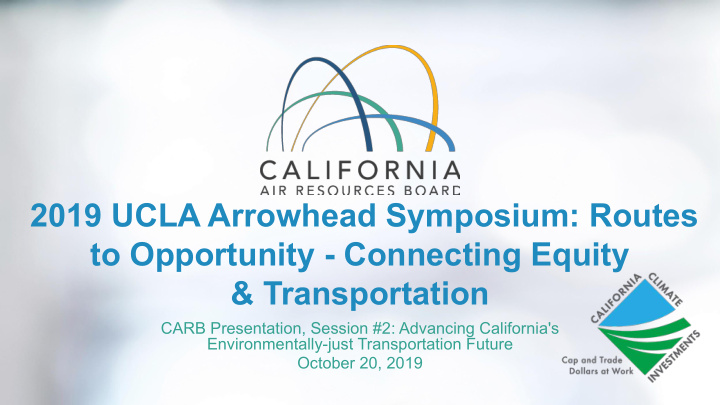



2019 UCLA Arrowhead Symposium: Routes to Opportunity - Connecting Equity & Transportation CARB Presentation, Session #2: Advancing California's Environmentally-just Transportation Future October 20, 2019
Connecting Transportation and Access • Critical for underserved communities • Increase access to goods/services, economic opportunities, in addition to general mobility • Want communities to have cleaner, safer, and more reliable mobility options available • Carefully balance access with other air quality goals • Presents need for broad investments across mobility options 2
Importance of Clean Transportation Equity • Access is a critical mechanism in achieving transportation equity • Helps defines our clean transportation future • Allows for better understanding barriers and how we can collectively overcome them 3
Access and Transportation Opportunities • Increasing access increases opportunities • Providing cleaner alternatives helps achieve goals • Statewide investments are: • helping to jump start transformation of the transportation sector • increasing clean transportation access • providing new clean transportation opportunities that also allow for access to essential services • Recognizing the challenges and importance of rural mobility in meeting climate goals 4
Funding Plan for Clean Transportation Incentives • Blueprint for expending the Low Carbon Transportation and Air Quality Improvement Program funds • Establishes priorities for the funding cycle • Describes policy drivers and the vision for advanced technology mobile source investments • A funding plan is submitted to the Board for approval each fiscal year • The Fiscal Year 2019-2020 Plan will be presented October 24 5
Policy Drivers and Guiding Documents 6
Role of Clean Transportation Incentives • Provide climate, air quality, and economic benefits • Accelerate development and deployment of clean technologies • Improve access to clean transportation • Benefit priority populations • Support State policies and goals • Complement other programs and investment strategies 7
Proposed Funding Allocations in FY 2019-20 Funding Plan • $533 million in clean transportation investments • $485 million for Low Carbon Transportation Program • $48 million for the Air Quality Improvement Program • Low Carbon Transportation includes: • $238 million in vehicle purchase incentives • $65 million in clean transportation equity investments • $182 million in clean truck and bus and advanced technology heavy-duty investments $1.7 billion appropriated to CARB for Low Carbon Transportation projects over the past six budget cycles 8
Clean Mobility Projects Our Ecosystem Community of Shared CarShare Mobility SMAQMD SJVAPCD CarSharing BlueLA $4.4M $2.25M & Mobility CarShare Hubs City of LA MTC Valley Air $4.7M Ag Valley $2.25M ZEV Vanpools Mobility CALVANS Statewide SJVAPCD $9M Clean Clean $0.75M Mobility in Mobility Schools Options EV Rural $10M CALSTART Transition School Bus $32M Program Pilot Community NCUAQMD Bridges $55M $0.27M 9
Vehicle Purchase Incentives & Outreach Clean Cars 4 All Multiple air One Stop districts $112M Shop Grid Alternatives Financing $5M Assistance Local: CHDC Statewide: BSF $35.9M 10
Project Overview • Addressing multiple barriers and needs through a broad portfolio of investments • Implementing a suite of clean mobility projects statewide • Main goal is to increase access to clean mobility options for low-income and disadvantaged communities • Promoting social and environmental equity • Offering alternatives to vehicle ownership and complimentary options: • Zero-emissions car share, shuttles, and vanpools • E-bike/bike share • First mile / last mile solutions and other mobility enhancements 11
Project Grantees and Partners • CARB pilots involve multiple project administrators • Rely on existing or new partnerships and networks including local air districts and community based organizations • Partnerships allow for: • Breadth of expertise • Broader understanding of community needs • Holistic approaches to overcoming barriers to clean mobility access • Processes in place to share and build from lessons learned 12
Equity: Building Strong Partnerships 13
How Have Clean Transportation Investments Changed? • Including community transportation needs assessments in project design at the onset • Providing funding opportunities for community transportation needs assessments to be conducted • Increasing opportunities for technical assistance and capacity building • More robust outreach and education efforts across programs • Increasing participation and project uptake • Streamlining application processes • Building on successes of previous investments and incorporate lessons learned 14
Benefits Achieved from Community Investments • Reduce greenhouse gases and localized pollution • Increase awareness of funding opportunities and mobility options available • Provide CARB with critical information to adapt policies and programs over time • Successes are found where we benefit the most residents and provide them with innovative solutions 15
Monitoring Progress of Investments • Increasing access to mobility options over time • Meeting targets for investments in low-income and disadvantaged communities • Economic, environmental, and public health co-benefits • Supporting ongoing implementation of SB 350 recommendation • Increasing participation and understanding where additional outreach or technical assistance is needed • Clean mobility improvements experienced by residents • Providing a portfolio of incentive programs that complement regulatory programs to reduce emissions and increase access 16
Barriers and Key Lessons Learned • Clean mobility projects are complex and take a lot of time to implement • Projects should consider the upfront time and investments needed to increase awareness and community partnership • Projects do not provide a one-size fits all solution • Clean transportation infrastructure installation is complicated • Multi-lingual outreach and on-site project support is critical to resident participation • Data from these projects and user experiences are helping inform future investments • Access to more predictable funding is critical for sustainability 17
Plan for Clean Transportation Equity • Continue funding clean transportation equity projects • Address community-identified transportation needs, including through new Sustainable Transportation Equity Project (STEP) • Transition from pilot phase and apply lessons learned • Identify pathways to make projects sustainable and continue community investments • Refine methods of measuring success • Continue collaboration across projects at state and local levels 18
Thank You! Contact Information: Ashley Georgiou, CARB Email: Ashley.Georgiou@arb.ca.gov Phone: (916) 440-8223 19
Recommend
More recommend